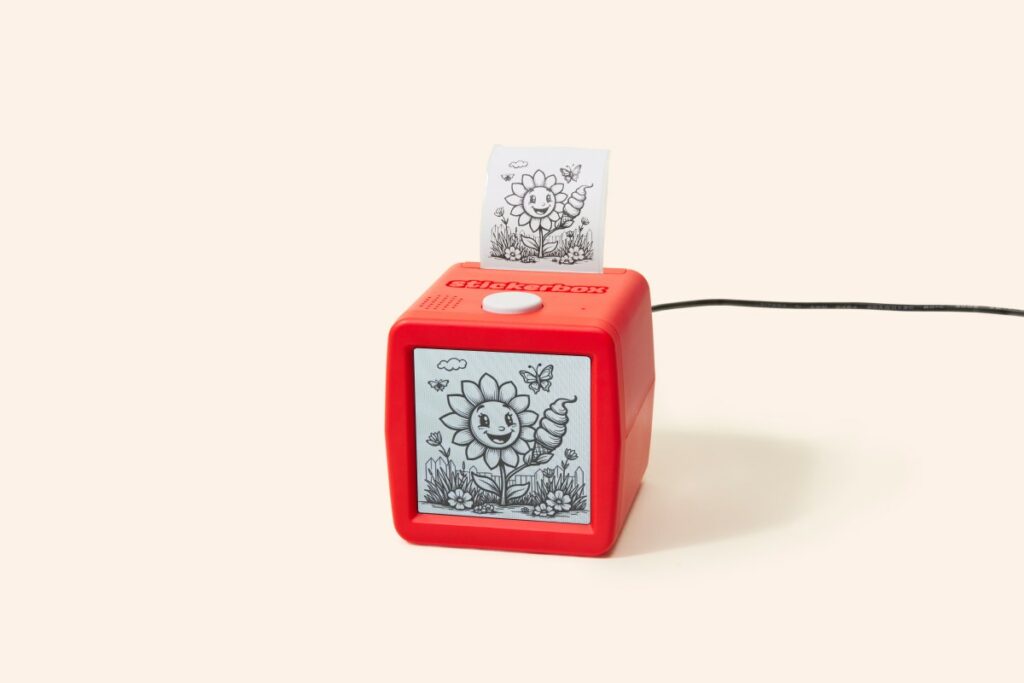There’s a new AI-powered toy for kids called Stickerbox, and, before you groan, I’m here to report that it’s surprisingly fun.
Stickerbox, a product born out of Brooklyn-based startup Hapiko, is a voice-activated sticker printer. The device takes whatever creative idea you have in your head and transforms it into a printed sticker that you can then color, peel, and stick anywhere.
Before trying the device itself, I have to admit I came with a preconceived negative bias — as did my fellow tester (my daughter). Our initial reactions were similiar: “An AI that prints stickers? I’d rather design and print my own.”
After trying the review unit sent by the company, we were won over.
Stickerbox, I realized, could represent a new form of creative play — and one that doesn’t outsource the child’s imagination to an AI model as much as you’d think.

Testing the AI sticker printer
The $99.99 toy itself is a small, bright red box with a black-and-white screen and a big, white “push-to-talk” button on top. It ships with three rolls of paper, which equates to 180 stickers, as well as a power cord and colored pencils.
The box’s color scheme is reminiscent of the Etch A Sketch, which makes sense, given that the Stickerbox feels like a modern spin on that concept. In the Etch A Sketch’s case, you have to learn how to control different knobs to create the image in your mind. With Stickerbox, those “knobs” are replaced with something more abstract: the voice commands you use to prompt the AI model.
Kids aren’t thinking about how to be better prompt engineers, of course; they’re just exploring their imagination and having fun seeing their ideas come to life. Any improvement in their prompting abilities is a side effect.
To initially set up the device, a parent will need to help. Much like adding a smart speaker to your home’s Wi-Fi, you have to first connect to the Stickerbox’s Wi-Fi, then enter the information to connect with your home network. The setup process, which only took a minute, went off without a hitch.

Using Stickerbox is simple. You push the button, describe an image out loud, then release the button to see your text appear on screen, followed by an AI-generated image as the printer spits out a physical copy.
There’s a serendipity to an experience in which you’re thinking of an idea and then holding it in your hand in a matter of seconds.
The device’s thermal image printer requires no ink, and the paper is BPS and BPA-free, making it safe to use.
The printed sticker is easy to tear off and then can be colored in with the colored pencils that come with the device. Your own crayons and markers also work. This combines the somewhat dopamine-driven experience of thinking up new things to print with the more calming or meditative aspects that come with coloring, similar to giving kids a coloring book.
This ended up offering a healthy balance between using potentially addictive tech and then slowing down to engage in a real-world activity. It also helped to address potential boredom.

The more you use the Sitckerbox, the more you realize how complex your prompts can be. You don’t just have to ask for a basic image, like a “magical unicorn,” you can speak to the Stickerbox with long, train-of-thought commands, and the AI parses what you mean. (This is particularly useful given that kids don’t tend to explain things in a straightforward fashion.)
Making “AI for Kids”
Hapiko, the company behind Stickerbox, was founded this year by CEO Arun Gupta and CTO Robert (Bob)Whitney. The pair originally met while working at the e-commerce marketplace Grailed, where Whitney was director of engineering and Gupta was CEO. (The company sold to GOAT Group in 2022.)
Before Grailed, Gupta founded and launched the Y Combinator-backed hardware sleep tracker WakeMate.

Whitney, meanwhile, had worked as the director of engineering at The New York Times’ Games division, as the publisher pivoted from offering just crosswords to becoming a full-fledged gaming app, acquiring Wordle and launching other games like Connections and Strads. While that experience taught him a lot about what makes a great consumer-facing product, his later stint at Anthropic gave him a first-hand look at the advances in AI technology.
However, it was his experience as a father that inspired Stickerbox.
When his son asked for a coloring page he didn’t have on hand, he turned to ChatGPT to make a printable image.
“I made it for him — a tiger eating ice cream. And he had never seen a printer before. I got out from under the bed, our HP brother printer — literally dusted it off and printed it for him, and he ran off happily and started coloring it,” explained Whitney. “But, a minute later, the gears were turning, and he came back to me, and he was like, ‘I want a lizard riding a skateboard.’ And I was like, okay, cool, let me make that for you.”
His son was so thrilled with the process of being able to say something and see it come to life that he realized there could be something to this.
“I just saw this look on his face of magic — like pure magic,” noted Whitney.
The co-founders were also thinking about how AI technology offered so many novel experiences, but most weren’t made for kids.
“Nobody’s building AI specifically for kids. So that’s what we’re looking for,” said Gupta. “What are the right guardrails? What are the right ways? What are the right products?”

They realized that kids have great imaginations, ideal for working with an AI image model.
“[They have] endless imagination and creativity … they’re learning new things every day. Every week, they’ve got a new obsession. We’re literally the first people in the world, I think, to put an image model inside of a box,” Gupta said.
Built for Updates
Under the hood, Stickerbox actually uses a combination of AI models, including its own proprietary tech focused on making the device kid-safe. It won’t respond to requests for harmful content, like violence or sexual imagery, and it filters out swear words. And if you try a somewhat more innocuous command, like “boobs,” it just prints a random sticker that may be vaguely related to the word. (For instance, you might get a generic cartoon girl, but not a large-chested one.)
After trying and failing to get a naughty result, most kids will likely go back to just prompting the device for silly images instead.
“We want to be the trusted brand for parents where you don’t have to look over your kid’s shoulder and be like, ‘what are they doing? How are they using this?,” said Gupta.
For now, the company generates some revenue from the device sales, but it keeps the cost of restocking paper low. It’s just $5.99 for three rolls, which equates to 180 stickers. (It’s currently running a promotion that offers six rolls with every purchase now.)
Over time, the team plans to explore adding premium features, including a way to upload your own image to imagine yourself in fantastic scenarios or collaboration tools.
As a Wi-Fi-connected device, the Stickerbox is regularly updated with new firmware and features. In tests, for instance, we were able to print some recognizable characters, but a more recent update added new guardrails to guide kids toward more original designs.
A soon-to-launch companion app also lets you view past creations and save favorites, and could ultimately serve as the home for premium features.
Stickerbox is backed by $7 million in funding from Maveron, Serena Williams’ Serena Ventures, the Allen Institute’s AI2 incubator, and various angels, including Matt Brezina, and product leaders from other consumer apps.


